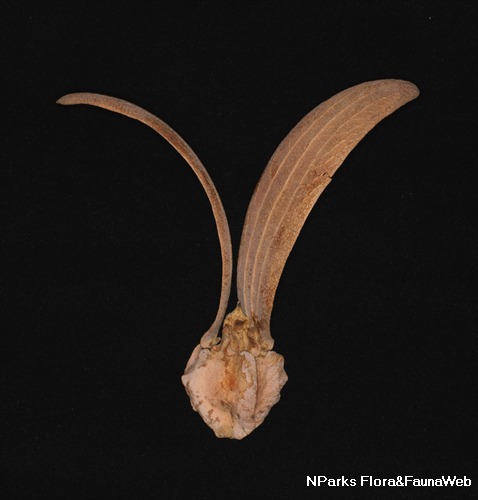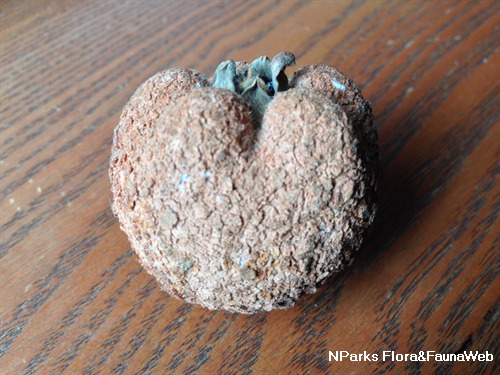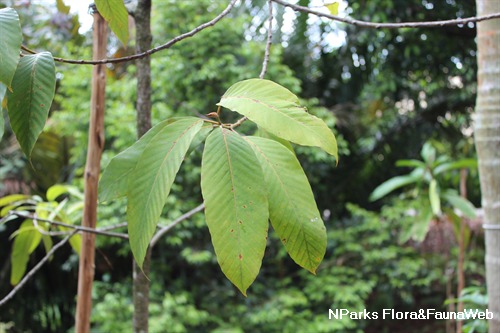_lowres.jpg)
Back
Dipterocarpus costulatus Slooten
| Family Name: | Dipterocarpaceae |
| Common Name: | Keruing Kipas, Keruing Pekat, Keruing Ladan, Keruing Marakluang Keruing Mara Keluang, Keruing Paya |
Dipterocarpus costulatus, also known as Keruing Kipas, is an emergent tree growing up to 50 m tall. It has leathery leaves with 11 – 14 pairs of prominent veins and produces winged fruit. It is prized for its hard timber which is often used for medium to heavy construction.
Name
Classifications and Characteristics
| Plant Division | Angiosperms (Flowering Seed Plants) |
|---|---|
| Plant Growth Form | Tree |
| Lifespan (in Singapore) | Perennial |
| Mode of Nutrition | Autotrophic |
| Plant Shape | Irregular |
| Maximum Height | 50 m |
Biogeography
| Native Distribution | Peninsular Malaysia, Sumatra and Borneo. |
|---|---|
| Native Habitat | Terrestrial |
| Preferred Climate Zone | Tropical |
| Local Conservation Status | Non-native (Horticultural / Cultivated Only) |
Description and Ethnobotany
| Growth Form | It is a tree, up to 50 m tall and 1.2 m diameter, with buttresses. Bark is pale cream green coloured. Cut surfaces of the sapwood may exudate a sticky oil. |
|---|---|
| Foliage | The leaves are broadly elliptic to ovate (12 – 20 cm long and 7 – 14 cm wide) and have a leathery texture. Each leaf has 11 – 14 pairs of prominent veins and parallel folds which gives it a corrugated or ribbed appearance. The underside of the leaf is smooth and without scales (glabrous). The leaf tip is obtuse to shortly acuminate while the leaf base is bluntly wedged shaped (cuneate). The leaf stalk (petiole) is 3 – 6 cm long. Buds occur at the end of the twigs and are protected by sheathing stipules. These stipules are strap shaped (lorate), up to 16 cm long and 2 cm wide. They are light coloured with a pastel pink tinge, especially during growing season. The inner surface of the stipule is densely covered with soft hairs (pubescent). When the stipules fall off, they reveal young folded leaves and another expanding bud, while leaving behind prominent stipule scars. |
| Flowers | Flowers occur in a cluster (raceme) at the axillary position. Each inflorescence is up to 20 cm long and bearing flowers at about 4 cm interval. The flower bud can reach up to 3 cm long and 1.5 cm wide. Each flower has about 24 stamens with linear anther and an ovoid ovary which is densely covered with soft hairs (pubescent). Flowers are reportedly fragrant and bloom in the evening. |
| Fruit | The fruit is woody and winged. Each fruit has 2 longer calyx lobes (about 20 cm long and 4 cm wide) and 3 shorter lobes (up to 7 cm long and 6 cm wide). The calyx tube is almost round (about 1.5 cm long and 2 cm wide), with 5 distinct flange-like median tubercles. |
| Habitat | It is found in low-lying forest with nutrient poor soil and subjected to inundation, as well as hill forest, up to 600m in altitude. |
| Associated Fauna | Flowers are reportedly pollinated by moths. |
| Cultivation | It can be propagated by seed. |
| Etymology | Genus Dipterocarpus is from Greek words "dipteros" which means 'two-winged' and 'karpos' which means 'fruit' and they refer to the character of the fruit. The specific epithet costulatus, in Latin, means ‘slightly ribbed’ with reference to the leaf blade appearance. |
| Ethnobotanical Uses | Timber & Products: In Malaysia, it is one of the key sources of Keruing timber and the wood is often used for medium to heavy construction. |
Landscaping Features
| Landscape Uses | Parks & Gardens |
|---|
Fauna, Pollination and Dispersal
| Pollination Method(s) | Biotic (Fauna) |
|---|---|
| Seed or Spore Dispersal | Abiotic |
Plant Care and Propagation
| Light Preference | Full Sun |
|---|---|
| Water Preference | Moderate Water |
| Plant Growth Rate | Moderate to Slow |
| Rootzone Tolerance | Poor Infertile Soils |
| Propagation Method | Seed |
Foliar
| Foliage Retention | Evergreen |
|---|---|
| Mature Foliage Colour(s) | Green |
| Mature Foliage Texture(s) | Leathery |
| Foliar Type | Simple / Unifoliate |
| Foliar Arrangement Along Stem | Alternate |
| Foliar Attachment to Stem | Petiolate |
| Foliar Venation | Pinnate / Net |
| Foliar Margin | Entire |
| Foliar Apex - Tip | Acuminate, Obtuse |
| Foliar Base | Cuneate |
Non - Foliar and Storage
| Trunk Type (Non Palm) | Woody |
|---|---|
| Root Type | Underground |
Floral (Angiosperm)
| Flower & Plant Sexuality | Bisexual Flowers |
| Flower Grouping | Cluster / Inflorescence |
|---|---|
| Flower Location | Axillary |
| Inflorescence Type | Raceme |
| Flowering Period | Every Few Years |
| Flowering Opening Time | Night (dusk to dawn) |
| Flowering Habit | Polycarpic |
Fruit, Seed and Spore
| Mature Fruit Colour(s) | Brown |
|---|---|
| Mature Fruit Texture(s) | Leathery |
| Fruit Classification | Simple Fruit |
| Fruit Type | |
| Seed Quantity Per Fruit | Few (1-5) |
References
| References | Ashton, P.S. (1982). Dipterocarpaceae. In: van Steenis, C.G.G.J. (ed.) Flora Malesiana, ser.1, vol. 9, part 2, pp. 237–552, 575–600. The Hague/Boston/London: Martinus Nijhoff/Dr. W. Junk Publishers. Ashton, P.S. (2004). Dipterocarpaceae. In: Soepadmo, E., Saw L.G. & Chung, R.C.K. (eds) Tree Flora of Sabah Sarawak, vol. 5, pp. 63–388. Malaysia: Forest Research Institute Malaysia (FRIM)/Sabah Forestry Department/Sarawak Forestry Department. Soerianegara, I., & Lemmens, R.H.M.J. (Editors). 1993. Plant Resources of South-East Asia Volume 5 (1). Timber Trees: Major Commercial Timbers. Netherlands: Pudoc Scientific Publishers. 610 pages. Symington, C.F., Ashton, P.S. & Appanah, S. (2004). In: Barlow, H.S. (ed.) Foresters’ Manual of Dipterocarps. Malayan Forest Records, no. 16, 2nd ed. Kuala Lumpur: Forest Research Institute Malaysia/Malaysian Nature Society. |
|---|
Image Repository
Others
| Master ID | 29649 |
|---|---|
| Species ID | 3958 |
| Flora Disclaimer | The information in this website has been compiled from reliable sources, such as reference works on medicinal plants. It is not a substitute for medical advice or treatment and NParks does not purport to provide any medical advice. Readers should always consult his/her physician before using or consuming a plant for medicinal purposes. |

_lowres.jpg)
_lowres.jpg)



